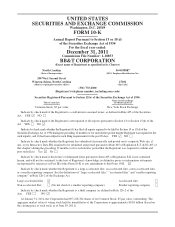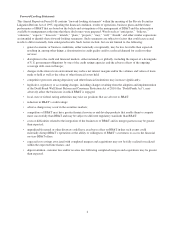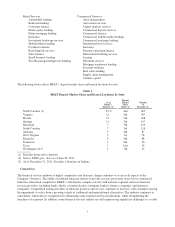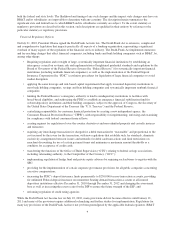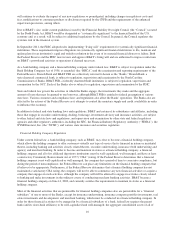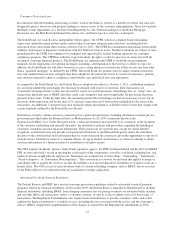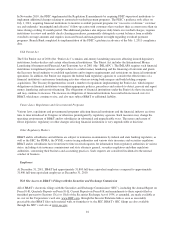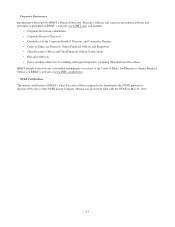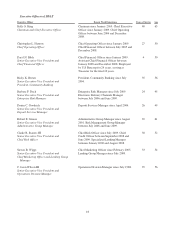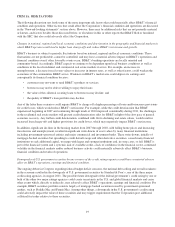BB&T 2011 Annual Report Download - page 11
Download and view the complete annual report
Please find page 11 of the 2011 BB&T annual report below. You can navigate through the pages in the report by either clicking on the pages listed below, or by using the keyword search tool below to find specific information within the annual report.that bank’s financial subsidiaries may not exceed the lesser of 45% of its consolidated total assets or $50 billion; the bank
must have at least a satisfactory CRA rating; and, if that bank is one of the 100 largest national banks, it must meet certain
financial rating or other comparable requirements.
Current federal law also establishes a system of functional regulation under which the Federal Reserve is the umbrella
regulator for bank holding companies, but bank holding company affiliates are to be principally regulated by functional
regulators such as the FDIC for state nonmember bank affiliates, the OCC for thrifts, the SEC for securities affiliates and
state insurance regulators for insurance affiliates. Certain specific activities, including traditional bank trust and fiduciary
activities may be conducted in the bank without the bank being deemed a “broker” or a “dealer” in securities for purposes
of functional regulation. Although the states generally must regulate bank insurance activities in a nondiscriminatory
manner, the states may continue to adopt and enforce rules that specifically regulate bank insurance activities in certain
identifiable areas.
The Dodd-Frank Act establishes additional regulation for bank holding companies, which will generally apply to BB&T.
The Council is required under the Dodd-Frank Act to monitor emerging risks to financial stability, recommend heightened
prudential standards for large, interconnected financial companies and require certain nonbank financial companies to be
supervised by the Federal Reserve if their activities are determined to pose a risk to financial stability.
The Dodd-Frank Act also imposes new prudential regulation on depository institutions and their holding companies. The
law imposes new, more stringent standards and requirements with respect to (1) bank and nonbank acquisitions and
mergers, (2) financial holding companies engaged in “financial activities,” (3) affiliate transactions and (4) proprietary
trading, among other provisions.
Office of the Comptroller of the Currency Regulation
As a federally chartered thrift, BB&T FSB is subject to regulation, supervision and examination by the OCC. BB&T FSB
was previously subject to regulation, supervision and examination by the OTS, until the OTS became a part of the OCC
on July 21, 2011, under the Dodd-Frank Act. Although the Dodd-Frank Act preserves federal thrift charters, the OCC
appointed a new Deputy Comptroller who will be responsible for supervising and examining federal savings associations.
The Dodd-Frank Act also eliminates the preemption of state consumer protection laws as applied to the operating
subsidiaries of federally chartered thrifts, which may cause BB&T FSB to further reconsider its existing organizational
structure and operations in the future.
Acquisitions
BB&T complies with numerous laws related to its acquisition activity. Under the BHCA, a bank holding company may
not directly or indirectly acquire ownership or control of more than 5% of the voting shares or substantially all of the
assets of any bank holding company or bank or merge or consolidate with another bank holding company without the
prior approval of the Federal Reserve. Current federal law authorizes interstate acquisitions of banks and bank holding
companies without geographic limitation. Furthermore, a bank headquartered in one state is authorized to merge with a
bank headquartered in another state, subject to any state requirement that the target bank shall have been in existence and
operating for a minimum period of time, not to exceed five years; and subject to certain deposit market-share limitations.
After a bank has established branches in a state through an interstate merger transaction, the bank may establish and
acquire additional branches at any location in the state where a bank headquartered in that state could have established or
acquired branches under applicable federal or state law. These regulatory considerations are applicable to privately
negotiated acquisition transactions.
Other Safety and Soundness Regulations
The Federal Reserve has enforcement powers over bank holding companies and their nonbanking subsidiaries. The
Federal Reserve has authority to prohibit activities that represent unsafe or unsound practices or constitute violations of
law, rule, regulation, administrative order or written agreement with a federal regulator. These powers may be exercised
through the issuance of cease and desist orders, civil money penalties or other actions.
There also are a number of obligations and restrictions imposed on bank holding companies and their depository
institution subsidiaries by federal law and regulatory policy that are designed to reduce potential loss exposure to the
depositors of such depository institutions and to the FDIC insurance fund in the event the depository institution is
11

